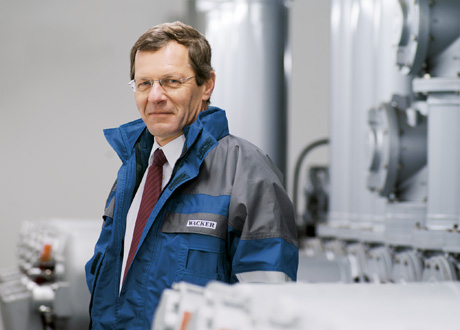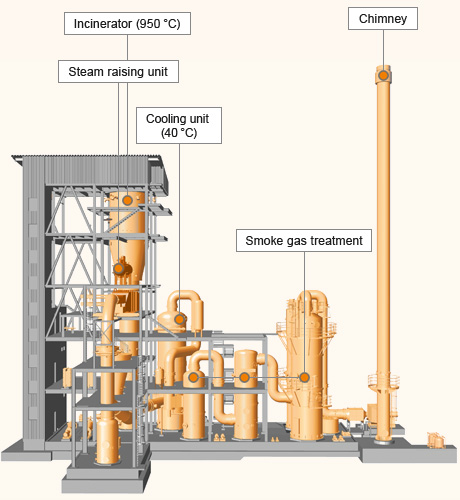How does a company increase production several times over while simultaneously reducing energy consumption and CO2 emissions? |
Work continues around the clock at the Nünchritz plant. WACKER has invested more than €600 million here over the last ten years and transformed Nünchritz into one of the world’s largest and most state-of-the-art silicone sites. |
WACKER utilizes waste heat and hot exhaust gases as useful heat for producing steam, saves energy by using several heat-integration systems, and employs a technically mature energy management system. |
|
|
A fresh wind is blowing over the site of the WACKER plant. Johann Eibl, a wiry man of medium build, pulls his collar up, adjusts his yellow protective helmet, and looks toward the sky. The silver-colored distillation columns that rise towards the clouds like enormous cigars reflect the sun’s rays. A truck drives past, and a forklift follows. Somewhere there’s knocking, and an echo of men’s voices. This is the soundtrack of chemical production in the small municipality of Nünchritz. |
|
|
Nünchritz, located in the middle of Saxony, is the most important WACKER site for silicone production after Burghausen. Production is going at full speed. The plant is growing – “and it’s more energy-efficient than ever,” affirms Johann Eibl with the deep voice and slightly rolling “R” that are typical for a Bavarian born near Regensburg. The head of the technical department and deputy site manager straightens his glasses and leads the way back to his office to explain in detail how the following can work: substantially higher production while keeping energy costs under control at a time of sharply increasing energy prices, and simultaneously conserving the environment and resources. The Nünchritz plant produces up to 135,000 metric tons of siloxane per year by successively evaporating and condensing a mixture of liquid silanes in the distillation columns. To do this, WACKER requires, for example, heat energy from the burning of natural gas to produce the steam for the distillation. To cool and liquefy the various substances, electricity for the fans that provide the air cooling is also necessary. |
Keeping energy demand under control – in addition to cutting costs, energyefficient production protects the environment and conserves resources. |
|
Although the plant now produces around seven times more siloxane than it did ten years ago when WACKER acquired the site, it does not consume seven times the energy. Its steam requirements are lower in absolute terms than they were ten years ago. The plant has become both leaner and more productive, and that’s what makes it special. “Energy efficiency was an important topic for us from the start,” mentions Johann Eibl, who studied process and environmental engineering many years ago in Berlin. An important contribution to this was made by the POWER PLUS program. With its help, WACKER has been cutting its energy consumption throughout the Group by 10% annually since the beginning of 2007. In Nünchritz, there were, and remain, many starting points for this strategy. The most prominent are the distillation columns, the plant’s landmark that can be seen from miles around. They are operated as a heat-integration system where it makes sense and is feasible. Previously, each column was supplied with energy individually and autonomously to get the distillation process started. Today, the energy-rich gaseous distillate in one column heats the process of the following column – like playing dominoes with heat energy. |
An ambitious goal – with its POWER PLUS program, the WACKER Group is reducing energy consumption by 10% annually. |

|
Johann Eibl, 53, is head of the technical department and deputy manager of WACKER’s site in Nünchritz. He has been employed by the Group for twenty-five years now, ten of them at the Nünchritz site. His employees’ particular strengths? “Open-mindedness, reliability, and inventiveness.” |
|
“We are probably the first company anywhere in the world to use this process in silane chemistry,” notes Johann Eibl. The Group has filed a patent for the process. The result – each year, WACKER saves 200,000 metric tons of heating steam and 500 megawatt hours of electrical energy in distillation. “The generation of heating steam with natural gas costs us around €30 per metric ton. The heat-integration system saves us around €6 million per year.” The principle is catching on. The Burghausen site is also scheduled to use it in the future. In the area of waste gases, WACKER is also increasing energy efficiency. A disposal facility in the production process burns these residues, which are around 950 degrees Celsius when they leave the combustion chamber. The flue gas must be cooled to 40 degrees before it can be scrubbed. Previously, WACKER used cooling water for this entire drop in temperature. Today, the plant in Nünchritz performs an intermediate step. In a steam generator, the hot waste gas turns water into steam, and is itself cooled down to 270 degrees in the process. This way, 80,000 metric tons of heating steam per year is generated for other production steps in the plant. At the same time, WACKER saves 4.8 million cubic meters of cooling water and over €3 million, as it doesn’t have to buy as much natural gas or treat as much cooling water. |
|

|
A three-dimensional model of the residue incinerator at the Nünchritz site with a sophisticated heat recovery system. The incinerator disposes of the gaseous and liquid production residues from the entire site. Per year, it produces approximately 80,000 metric tons of heating steam and saves approximately 4.8 million cubic meters of cooling water. |
|
However, smaller improvements also contribute to a reduction in energy costs in Nünchritz. In 2007, 150 employees, primarily shift workers and skilled laborers, participated in an energy-saving campaign which is part of the plant’s employee suggestions system. The resultant overall benefit is savings of €200,000. “When it comes to energy-related topics, our employees are particularly imaginative and motivated,” Johann Eibl confirms. The energy savings achieved in the plant as a whole are impressive. The specific consumption of steam fell by around 70% over the past ten years, while power consumption per metric ton of product also fell by around 70%. The energy-saving measures are now helping to prevent the emission of over 60,000 metric tons of CO2 – this represents a decrease of over 80% in CO2 emissions. The plant has its energy costs under control, even though natural gas prices have risen 50% since 2005, and electricity costs have more than doubled since 2004. “We have spent almost €8 million on the energy-saving measures, and, since 2008, we have been saving around €12 million per year,” concludes Johann Eibl. |
Small steps can have a great effect. An energy-saving campaign as part of the plant’s employee suggestions system saved a total of €200,000. |
|
What does the future hold? “Energy efficiency will continue to be an important topic in the future,” the WACKER manager remarks, indicating to his left. He looks out the window to a large construction site: cranes, trucks, workers, bare brickwork, soil, structural elements, hustle and bustle. In Nünchritz, WACKER is building a new production facility for polysilicon which also features complex heat-integration systems. Approximately €800 million is being invested, and 450 new jobs are being created. The new plant is scheduled to start production in 2011. Until then, it will be probably the biggest construction site in Saxony. “I think that’s great,” adds Johann Eibl with a smile. He likes construction sites, even though the office trembles sometimes. It’s good when things are on the move. |
Energy efficiency is a permanent priority. As the Nünchritz plant is extended, using energy wisely remains a key issue in the future. |